Crafting a Human-Centered Strategy: A Modern Human-Centered Design of Organizations
Discover the essence of a human-centered strategy. Merge human-centric insights with problem-solving for impactful solutions.
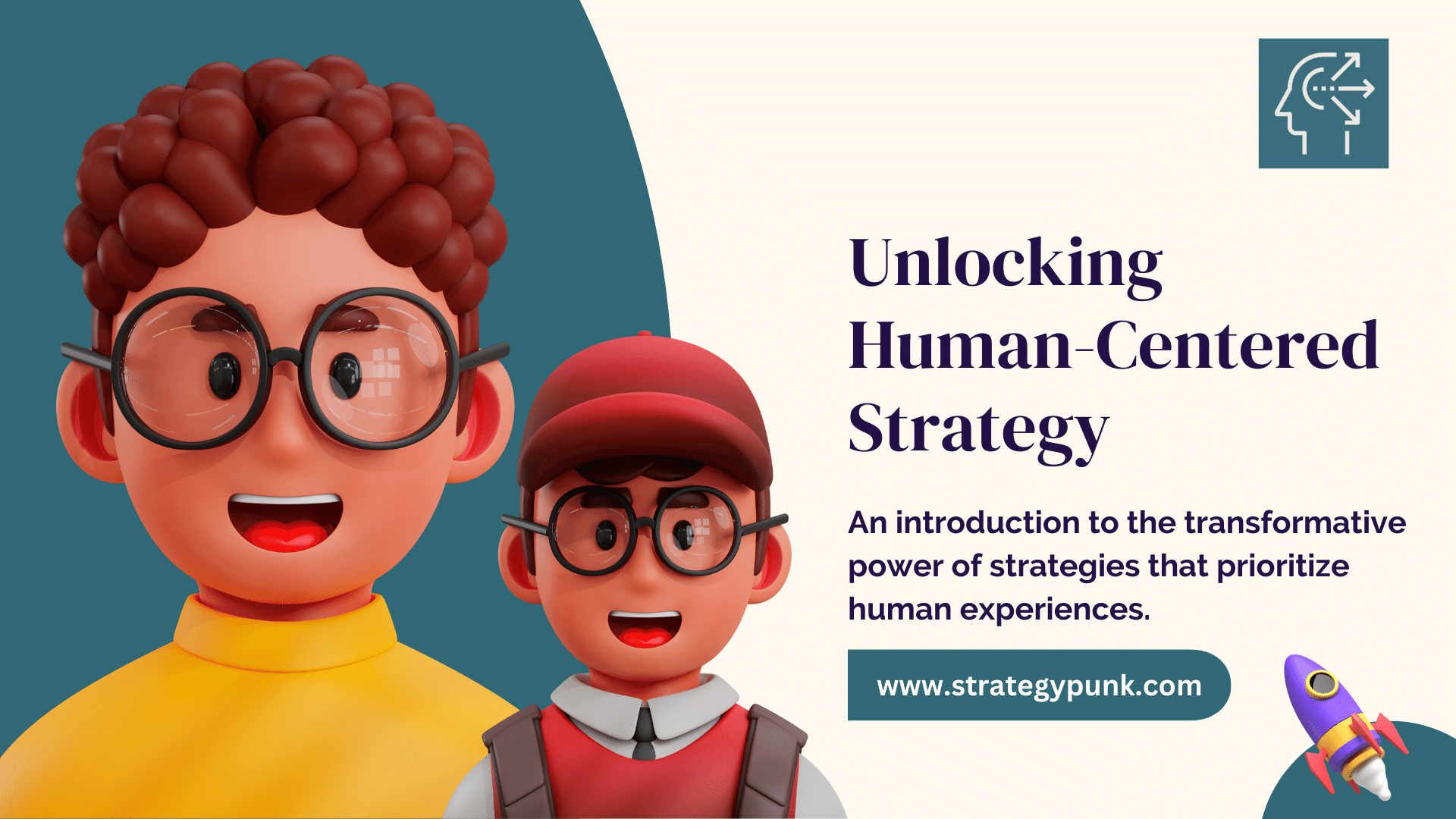
Introduction
As the business landscape evolves, organizations must adapt to remain competitive. One approach that has gained traction in recent years is the human-centered strategy. This approach places the needs and experiences of stakeholders at the forefront of decision-making, resulting in more meaningful and impactful outcomes.
What is a human-centered strategy, and why should modern organizations adopt it? This guide will explore the key components of a human-centered design, the benefits of adopting a critical approach, and the challenges organizations may face. By the end of this article, readers will have a clear understanding of how to craft a human-centered strategy that drives success and creates value for all stakeholders.
Key Takeaways
- A human-centered strategy places the needs and experiences of stakeholders at the forefront of decision-making and problem-solving.
- Adopting a human-centered approach can lead to more meaningful and impactful outcomes.
- Crafting a successful human-centered strategy requires careful consideration of critical components, stakeholder involvement, and metrics for measuring success.
The Evolution of Business Strategy
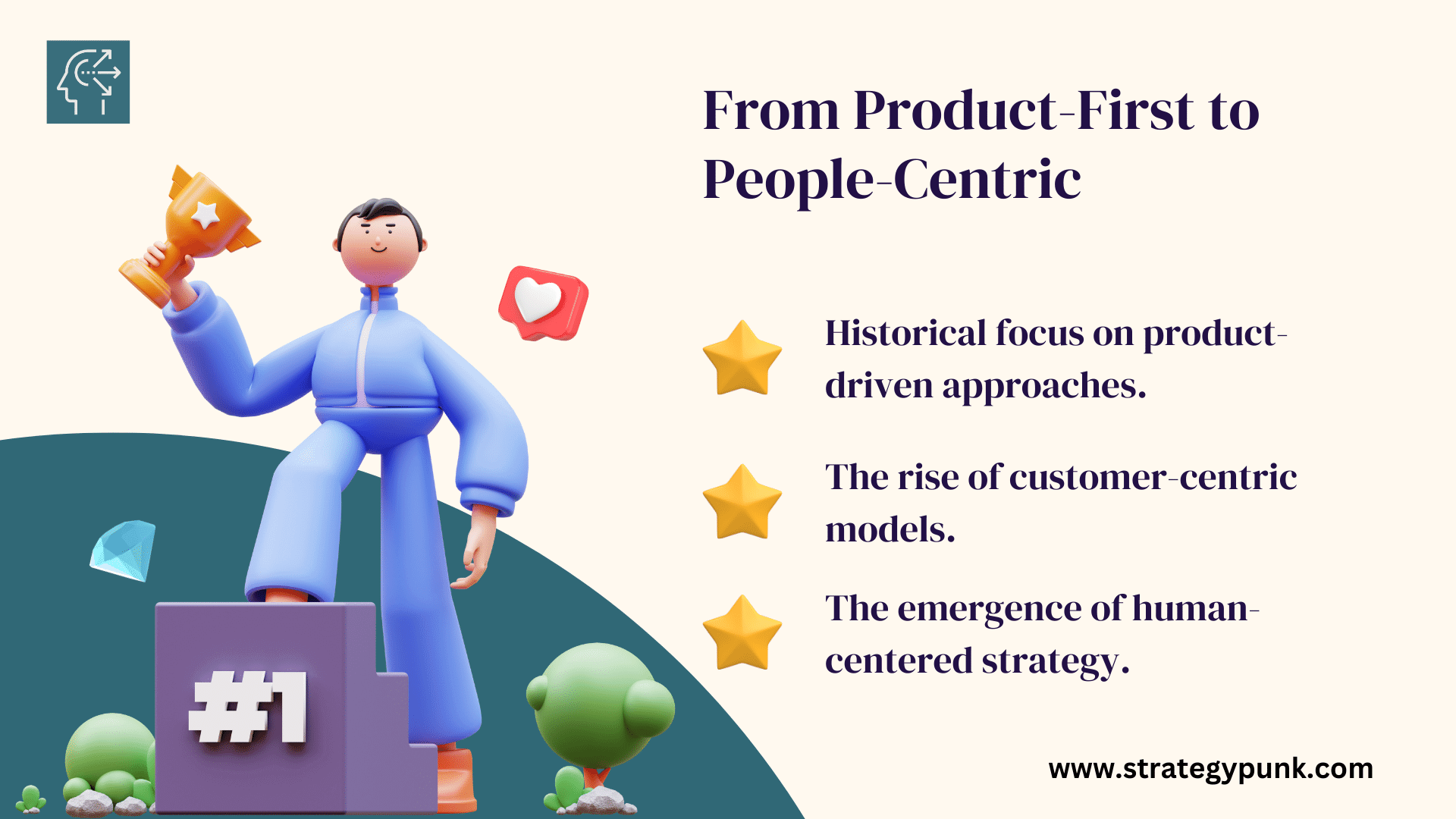
Traditional methods and their limitations.
Traditional business strategies focus on maximizing profits and shareholder value, often at the expense of customer satisfaction and employee well-being. However, as markets became more competitive and consumers became more empowered, businesses began to realize the limitations of these approaches.
The rise of customer-centric models.
The rise of customer-centric models shifted the focus towards understanding and meeting the customer's needs. This approach emphasized the importance of building long-term customer relationships and providing personalized experiences that would keep them returning.
More recently, the concept of a human-centered strategy has emerged. This approach goes beyond customer-centricity to encompass the needs and experiences of all stakeholders, including employees, partners, and the wider community.
Introduction to the concept of a human-centered workplace.
A human-centered strategy seeks to create value for all stakeholders, not just shareholders, by understanding their needs and designing solutions that meet those needs sustainably and responsibly. By putting people at the center of their strategy, organizations can build trust, loyalty, and resilience and create long-term value for everyone involved.
What is a Human-Centered Strategy?
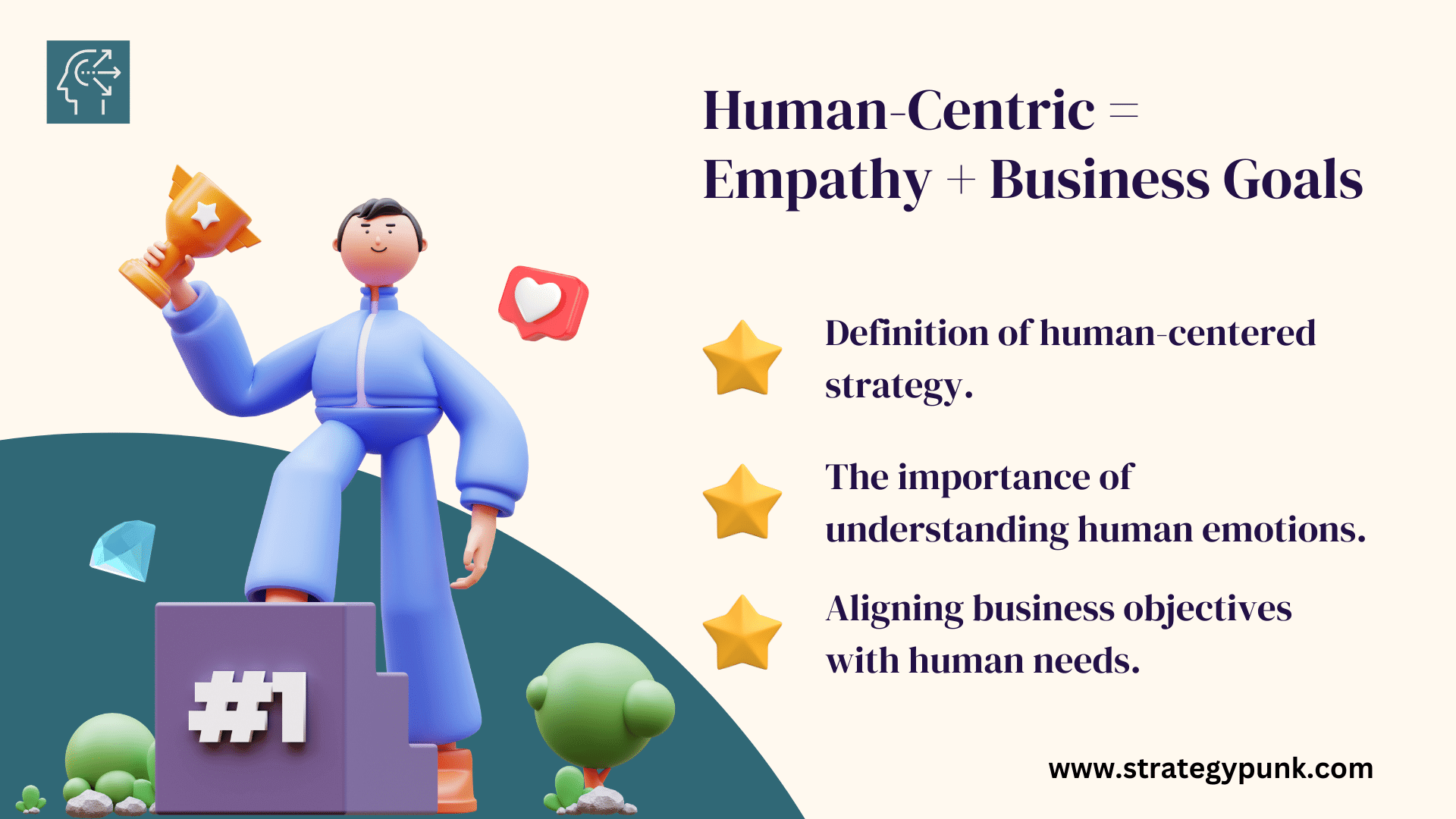
Definition and core principles. A Human-centered design for solving business problems
A human-centered strategy is a people-centric approach to solving business problems. It involves designing solutions based on a deep understanding of the needs, wants, and behaviors of the people who will use them. This approach puts the user at the center, ensuring the end product is valuable and delightful.
Human-centered design is the core principle of a human-centered strategy. It is a creative problem-solving approach that starts with empathy for the user. This approach involves understanding the user's needs, wants, and pain points and designing solutions that meet those needs. Human-centered design is a collaborative process involving designers, developers, and users working together to create functional and beautiful solutions.
The shift from product-centric to people-centric approaches.
The transition from product-centric to people-centric methods has been driven by the rise of technology and consumers' changing expectations. In the past, companies focused on creating efficient and cost-effective products. Today, consumers expect products that are easy to use, intuitive, and personalized to their needs.
The intersection of empathy, technology, and business goals.
A human-centered strategy comes into play at the intersection of heart, technology, and business goals. By understanding the user's needs and wants, companies can design products that are not only useful but also delightful. This approach can increase customer satisfaction, loyalty, and business success.
The Psychological Perspective for Human-Centered Design
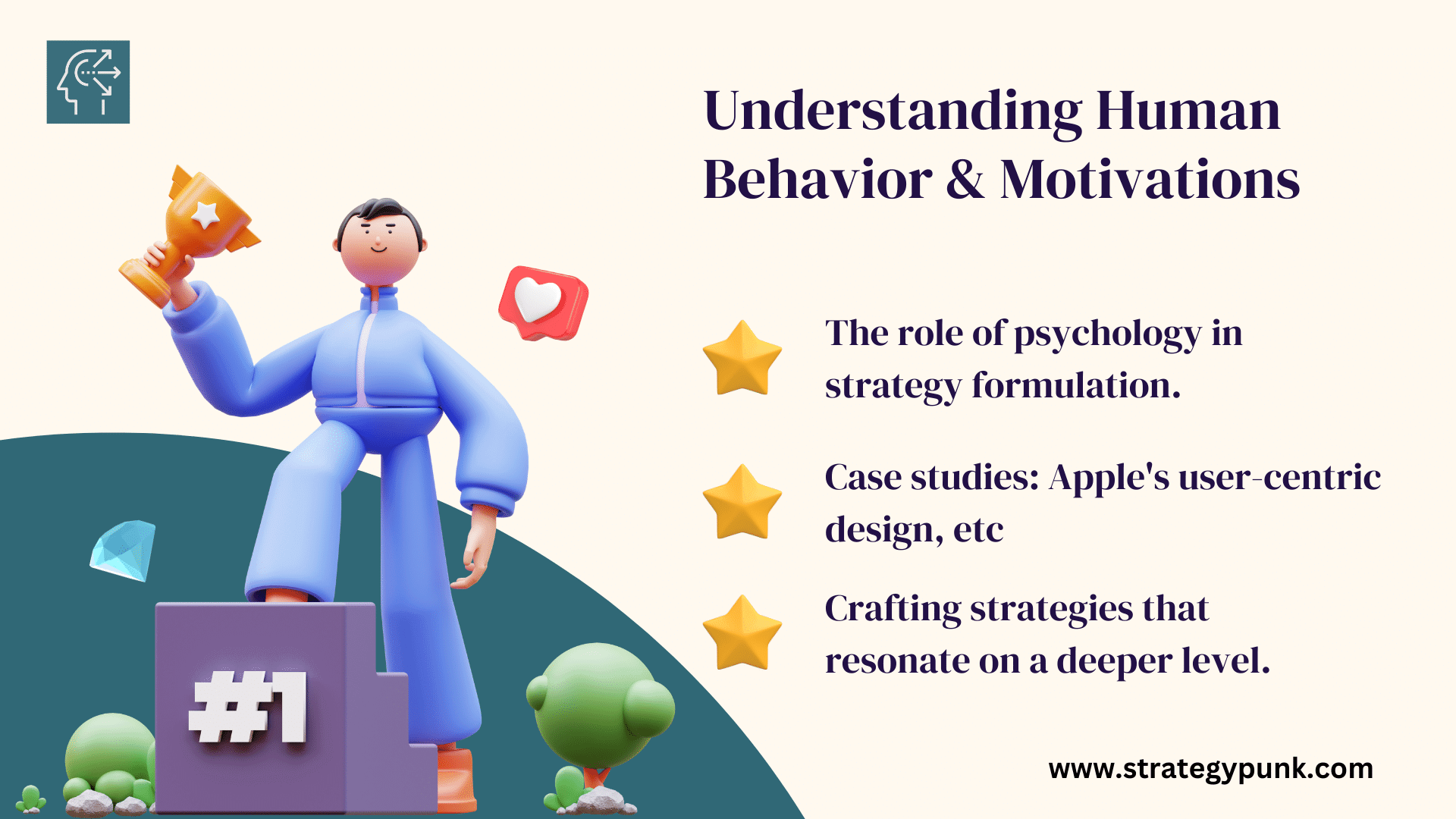
Understanding human behavior and motivations.
Understanding human behavior and motivations is crucial to crafting a human-centered strategy. It involves identifying the psychological factors influencing people's decision-making and behavior towards a product or service. By gaining insights into user psychology, organizations can tailor their strategies to meet their target audience's specific needs and preferences.
The role of empathy in strategy formulation.
The role of empathy in strategy formulation cannot be overstated. Empathy enables organizations to put themselves in their users' shoes and understand their pain points, motivations, and aspirations. By empathizing with their users, organizations can create products and services that resonate with them and deliver a superior user experience.
Case studies showcasing the impact of understanding user psychology.
There are abundant case studies showcasing the impact of understanding user psychology. For instance, Apple's success can be attributed to its ability to understand its users' psychology and create products that cater to their needs and preferences. Similarly, Amazon's recommendation engine is based on its understanding of user behavior and preferences, enabling it to deliver a personalized shopping experience.
Why Adopt a Human-Centered Approach to Business?
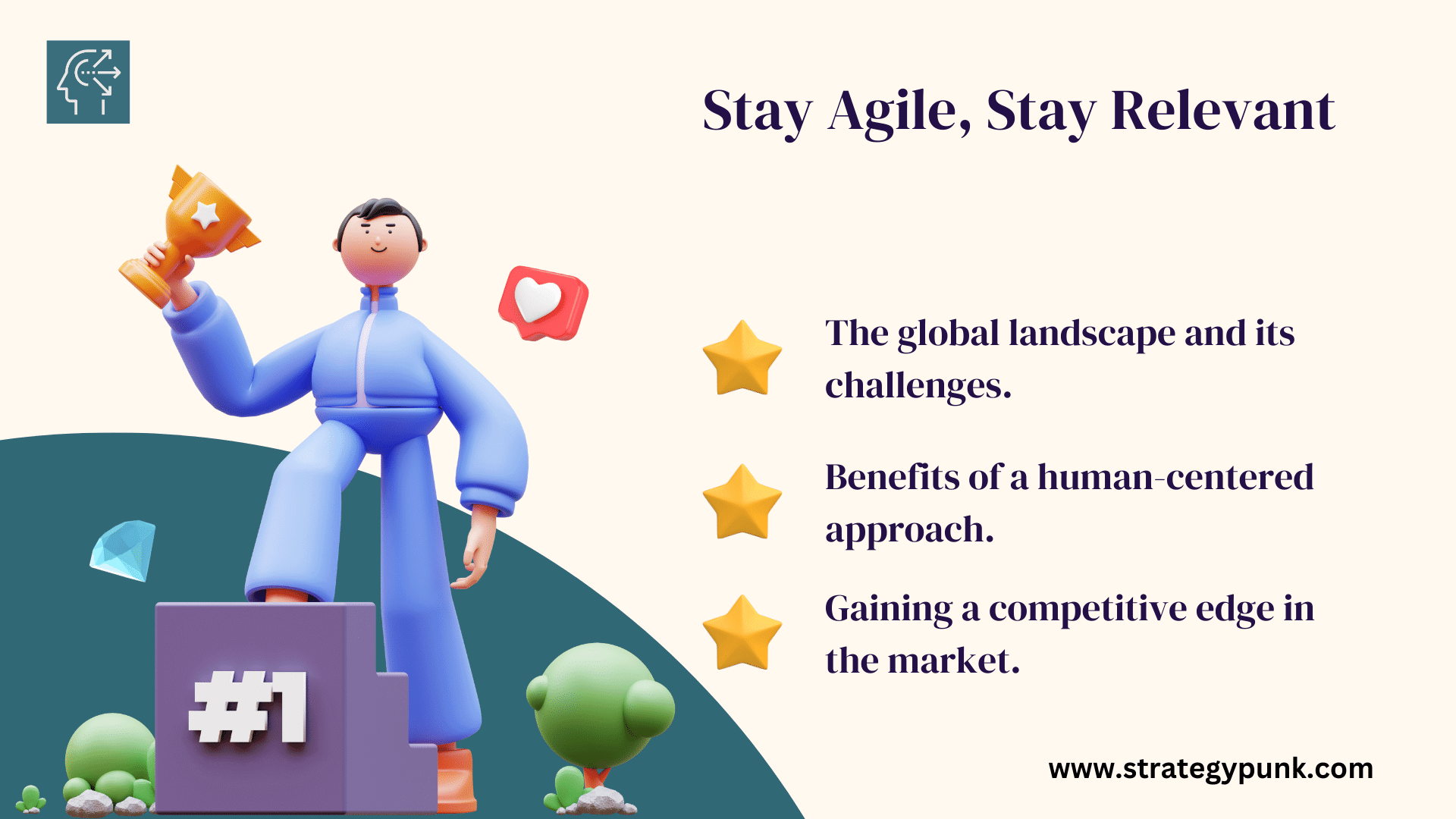
Addressing the convergence of various global challenges.
Addressing the convergence of various global challenges requires organizations to adopt a human-centered approach to business. This approach considers people's needs and wants while designing products, services, and experiences. By doing so, organizations can enhance human experiences, foster innovation, and build resilient brands.
Benefits: Enhanced human experiences, fostering innovation, and building resilient brands.
Adopting a human-centered approach offers several benefits to modern organizations. It allows them to differentiate themselves from competitors by providing products and services tailored to their customers' needs. This, in turn, leads to increased customer loyalty and satisfaction, which translates into higher revenue and profits.
Moreover, a human-centered approach fosters innovation by encouraging organizations to think outside the box and develop creative solutions to complex problems. By involving people in the design process, organizations can better understand their needs and wants, which can lead to the creation of truly innovative and groundbreaking products and services.
The competitive edge it offers in the market.
A human-centered approach is essential for building resilient brands that can withstand the challenges of a rapidly changing business environment. By putting people at the center of their operations, organizations can create a culture that delivers value to customers and stakeholders. This, in turn, leads to a more engaged and motivated workforce that is better equipped to deal with future challenges.
Adopting a human-centered approach is essential for modern organizations that want to succeed in today's fast-paced and complex business environment. By putting people at the center of their operations, organizations can enhance human experiences, foster innovation, and build resilient brands that can withstand future challenges.
Critical Components of a Human-Centered Strategy Design Process
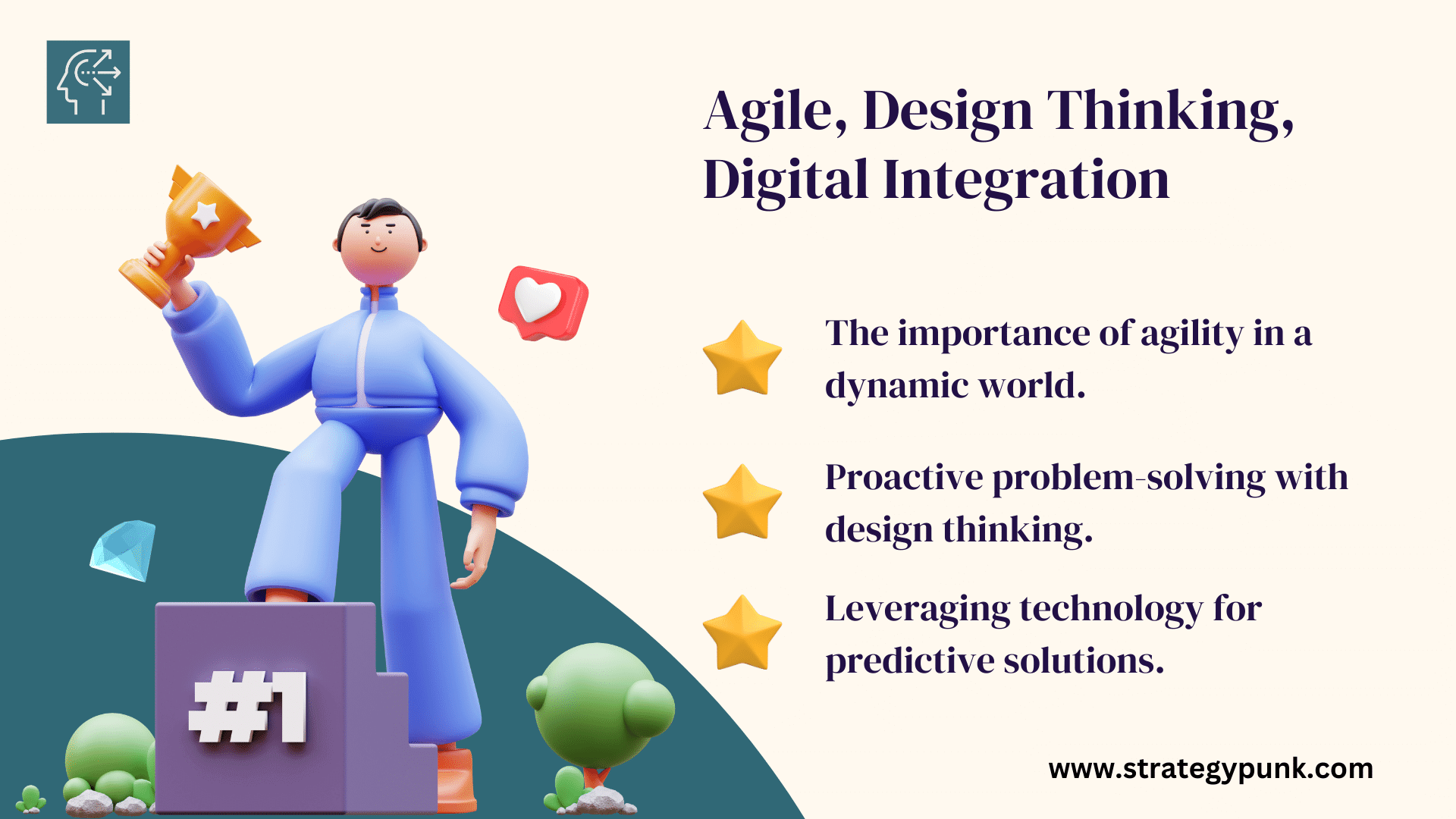
Modern organizations must focus on several key components to develop a successful human-centered strategy. These components include an agile approach, design thinking, and digital integration.
Agile Approach: Adapting to user needs, iterative feedback loops, and case studies.
This involves adapting to user needs using iterative feedback loops and case studies. This allows organizations to quickly pivot and adjust their strategies based on user feedback, resulting in a more effective and user-friendly product or service.
Design Thinking: Integrating design principles, user journey mapping, and prototyping.
Design thinking is another critical component of a human-centered strategy. By integrating design principles, user journey mapping, and prototyping, organizations can create products and services that meet their users' needs and desires. This approach ensures the result is functional, aesthetically pleasing, and enjoyable.
Digital Integration: Leveraging AI and analytics, understanding user behavior, and optimizing touchpoints.
Digital integration is crucial for a successful human-centered strategy. By leveraging AI and analytics, understanding user behavior, and optimizing touchpoints, organizations can create a seamless and personalized user experience. This approach enables organizations to meet the needs of their users across multiple channels and touchpoints, resulting in a cohesive and effective strategy.
By prioritizing these key components, modern organizations can develop a human-centered strategy that meets their users' needs and drives business success.
Stakeholder Involvement in Human-Centric Strategy Formulation (esp. for Problem-Solving)
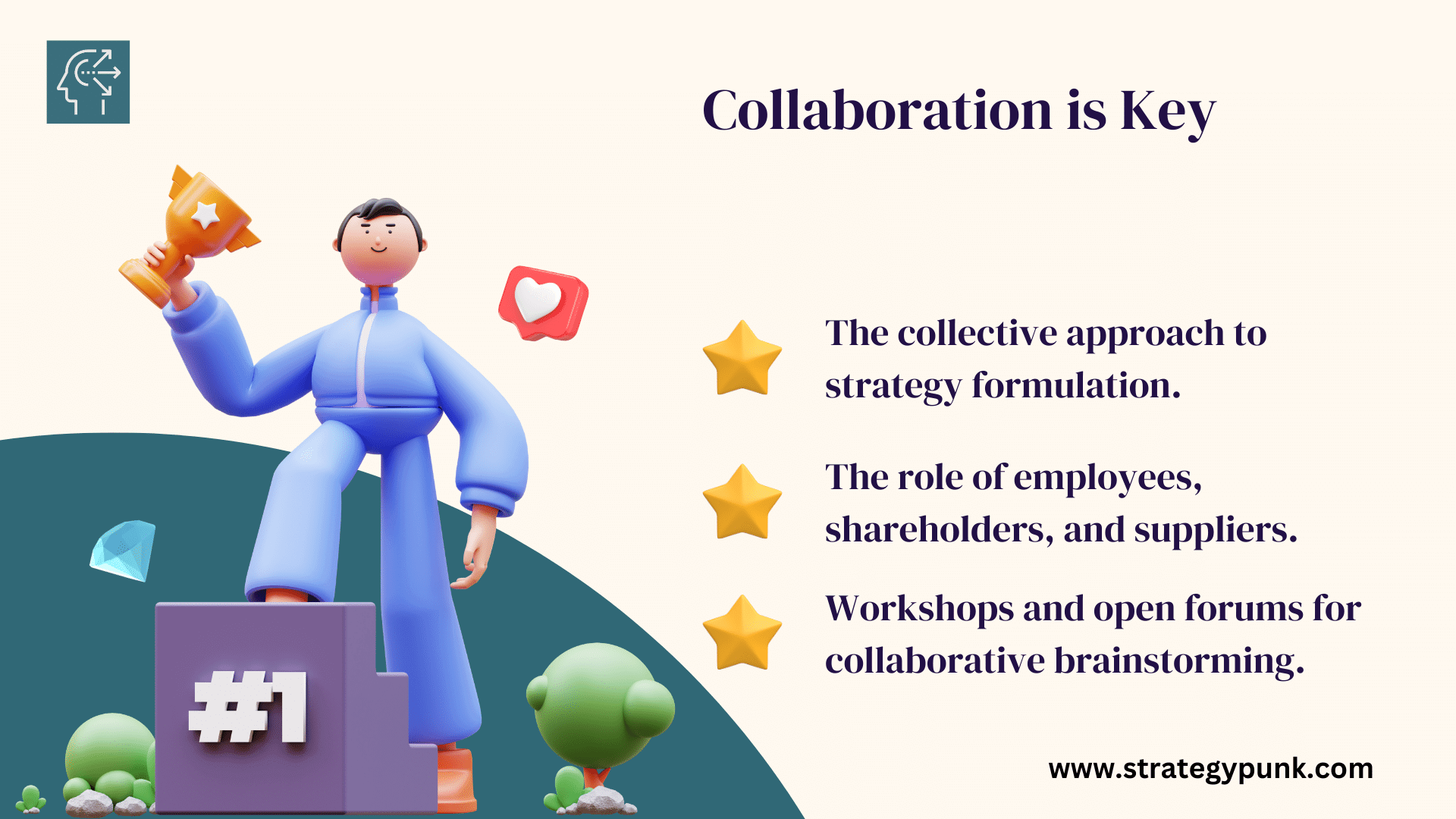
The importance of involving employees, shareholders, and suppliers.
Involving stakeholders in strategy formulation is essential for modern organizations. These include employees, shareholders, and suppliers. Organizations can gain valuable insights, perspectives, and ideas by using these groups to help shape the overall strategy.
Workshops, feedback sessions, and collaborative tools.
Workshops, feedback sessions, and collaborative tools effectively involve stakeholders in strategy formulation. These methods allow stakeholders to share their thoughts and ideas openly. This helps generate new ideas and fosters collaboration and ownership among stakeholders.
Benefits of a collective approach to human-centered strategy formulation.
The benefits of a collective approach to strategy formulation are significant. By involving stakeholders, organizations can create a strategy that is more aligned with their needs and expectations. This can lead to increased engagement, productivity, and profitability. Additionally, involving stakeholders in strategy formulation can help build trust and strengthen relationships between the organization and its stakeholders.
Involving stakeholders in strategy formulation is critical to crafting a human-centered strategy. By creating a collaborative and inclusive process, organizations can ensure that their system is aligned with their stakeholders' needs and expectations.
Measuring Success in a Human-Centered Strategy
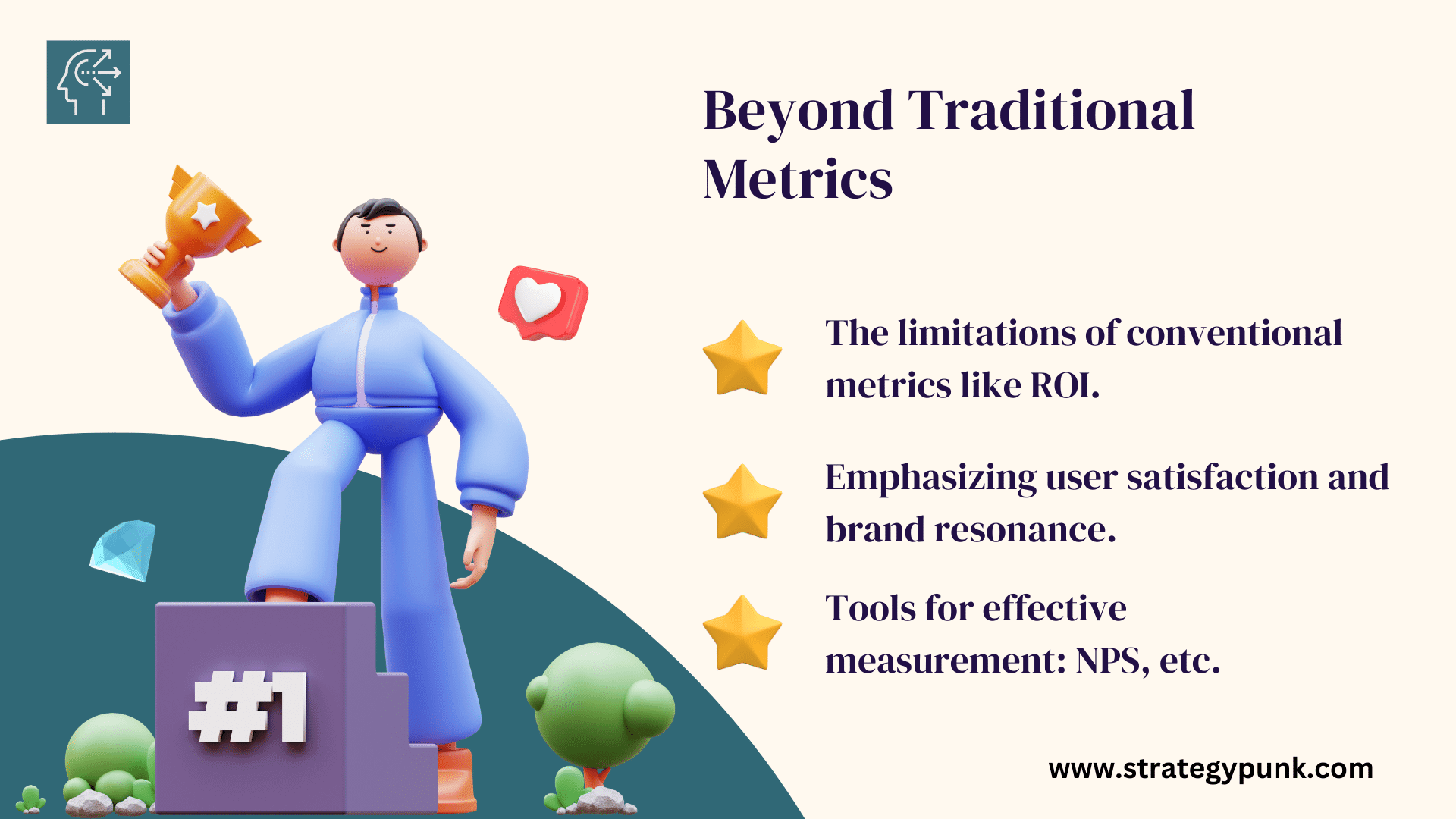
Measuring success in a human-centered strategy is crucial for modern organizations. It is vital to move beyond traditional metrics like ROI and focus on user satisfaction, employee engagement, and brand loyalty.
We are moving beyond traditional metrics like ROI.
Organizations can use surveys, feedback forms, and user testing to measure user satisfaction. These methods allow organizations to gather feedback directly from their users and improve based on their needs and preferences.
We are emphasizing user satisfaction, employee engagement, and brand loyalty.
Employee engagement can be measured through employee satisfaction surveys and by tracking employee turnover rates. Organizations can also use tools like pulse surveys to gather real-time employee feedback and make necessary changes to improve their experience.
Brand loyalty can be measured through customer satisfaction surveys and by tracking customer retention rates. Organizations can also use social media monitoring tools to track brand sentiment and identify areas for improvement.
Tools and platforms for effective measurement from theory and practice.
Tools and platforms for effective measurement include tools like Google Analytics, which can provide valuable insights into user behavior and website performance. Social media monitoring tools like Hootsuite and Sprout Social can help organizations track brand sentiment and engage with customers on social media.
Measuring success in a human-centered strategy requires focusing on user satisfaction, employee engagement, and brand loyalty. Organizations can gather valuable feedback and make necessary improvements using the right tools and platforms to create a better user and employee experience.
Challenges and Overcoming Them in the Workplace
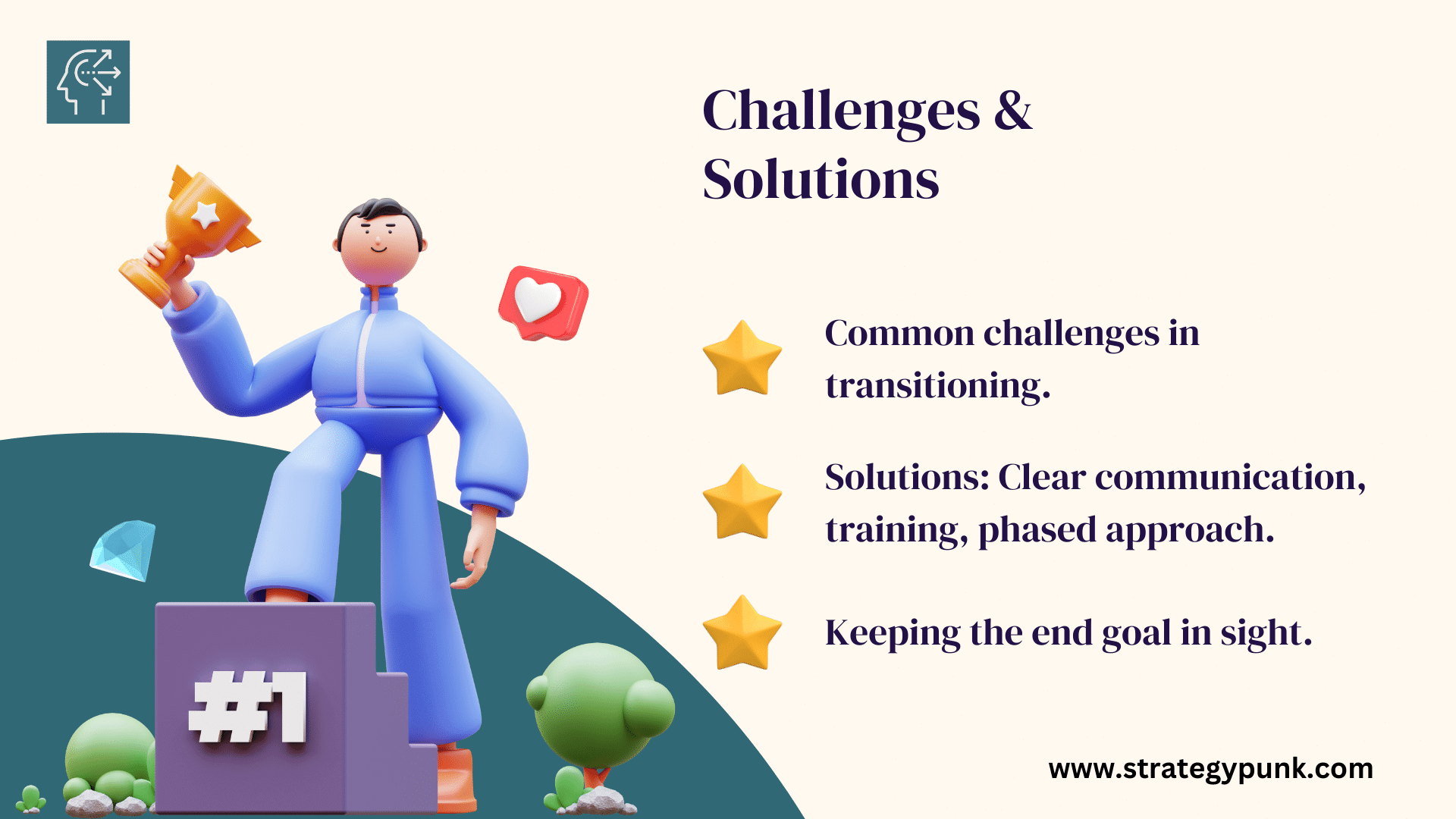
Common pitfalls when transitioning to a human-centered strategy.
Transitioning to a human-centered design can be challenging for modern organizations. Common pitfalls include a lack of buy-in from leadership, resistance to change within the organization, and a failure to fully understand customers' needs and desires.
Addressing opposition to change within the organization.
Managing resistance to change within the organization is crucial to the success of a human-centered strategy. This can be achieved by involving employees in the process, providing training and support, and communicating the benefits of the new approach. Leaders must also be willing to change the organizational structure and processes to align with the new strategy.
Case studies of challenges faced and solutions implemented.
Case studies of challenges faced and solutions implemented can provide valuable insights for organizations. For example, a large retail company struggled to implement a human-centered strategy due to a need for more understanding of their customers' needs. By conducting extensive research and involving customers, they created a more personalized shopping experience that increased sales and customer loyalty.
While transitioning to a human-centered strategy may present challenges, organizations can overcome them by involving employees, communicating the benefits, and conducting thorough research to better understand their customers' needs.
Implementing a Human-Centered Strategy
Steps and best practices for a smooth human-centric transition.
Organizations must follow critical steps and best practices to implement a human-centered strategy successfully. First and foremost, it is essential to establish a design process that prioritizes empathy and human needs. This involves conducting research, gathering insights about the target audience, and using this information to inform decision-making throughout the design process.
Training and workshops for teams.
In addition, organizations should provide training and workshops for teams to ensure they understand and embrace the human-centered approach. This can include teaching empathy-building techniques and methods for testing ideas with users.
Real-world examples of successful transitions.
Real-world examples of successful transitions to a human-centered strategy can also help guide the process. For example, Airbnb shifted its focus from listings to experiences, resulting in a more personalized and engaging platform for users. Similarly, IBM transformed its approach to product development by involving users in the design process and prioritizing their needs.
By following these best practices and learning from successful examples, organizations can adopt a human-centered approach that leads to innovative products and services that genuinely meet users' needs.
The Future of Human-Centered Strategy
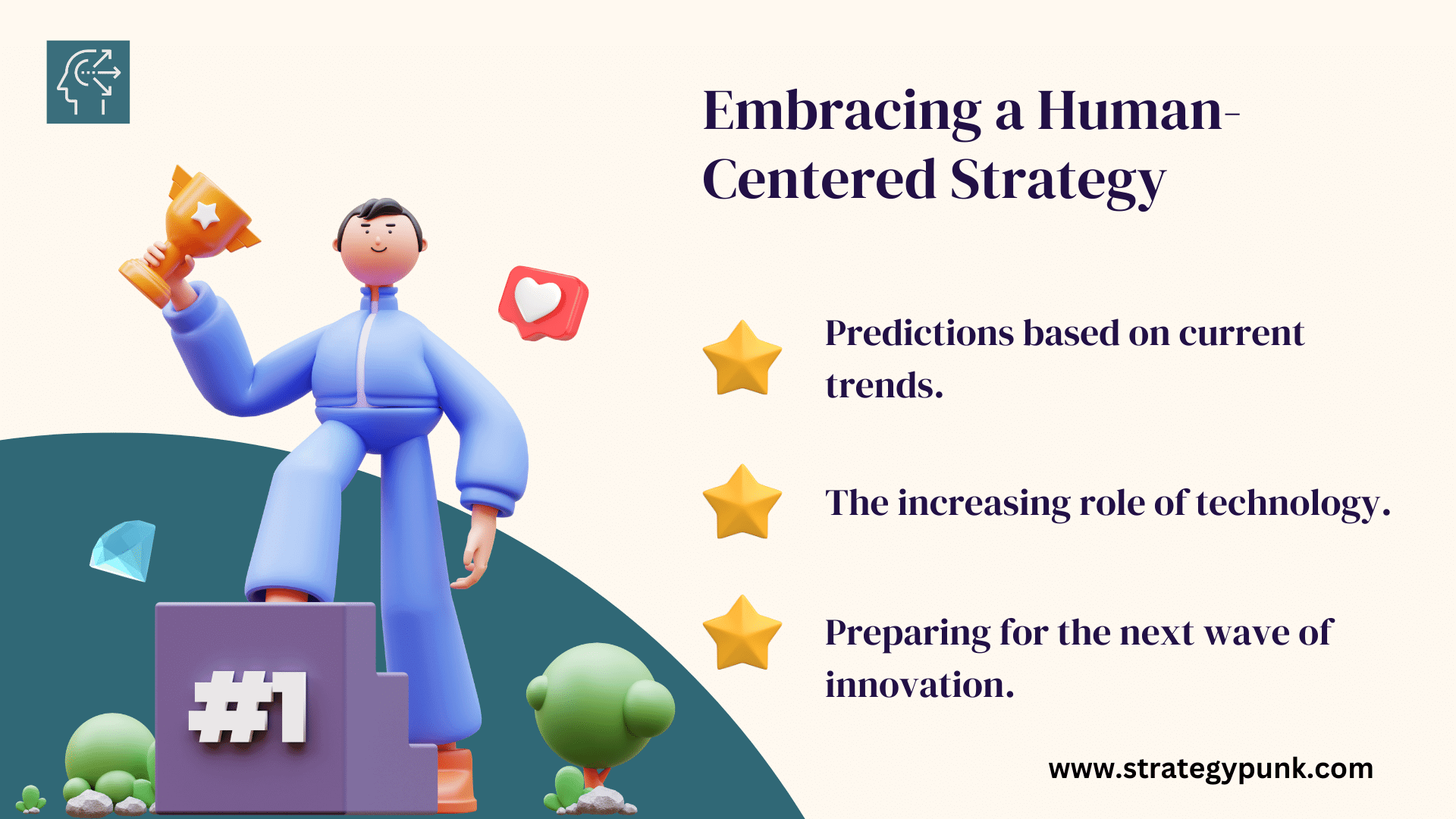
What does the future hold for organizations that continue to embrace human-centered strategies? Based on current trends, it's clear that this approach is here to stay.
Predictions based on current trends.
One key factor shaping the future of human-centered strategy is the increasing role of technology. Organizations will have even more opportunities to enhance human experiences as innovations emerge. Technology will be critical in creating meaningful connections between people and brands, from personalized recommendations to immersive virtual environments.
The increasing role of technology in enhancing human experiences.
Of course, with new technology comes new challenges. As organizations prepare for the next wave of innovation, they must stay ahead of the curve regarding privacy, security, and ethical considerations. By prioritizing human-centered design and user feedback, organizations can create technology that truly serves customers' needs.
We are preparing for the next wave of innovation.
Overall, the future of human-centered strategy is bright. By putting people at the center of everything they do, organizations can build lasting relationships with their customers and create experiences that truly resonate. As technology evolves, it will be exciting to see how organizations use it to enhance and elevate human experiences in new and innovative ways.
Conclusion
Recap of the importance and benefits of a human-centered strategy.
In conclusion, a human-centered approach is crucial for modern organizations' success. Organizations can better understand their customer's needs and expectations by placing people at the center of their operations. This understanding can lead to developing innovative products and services that meet the needs of customers and employees alike.
A call to action for organizations to prioritize people and innovation.
A human-centered strategy can help organizations build more vital customer and employee relationships. By prioritizing their needs and preferences, organizations can create a more positive and engaging experience for everyone involved.
Organizations must prioritize people and innovation to stay competitive in today's fast-paced business environment. By adopting a human-centered approach, organizations can create a culture of innovation that encourages creativity and experimentation.
Additional Resources
Various resources are available online to further hone your skills in crafting a human-centered mindset. These resources include recommended readings, online courses, workshops, and tools to help you learn more about the topic.
Recommended readings, online courses, workshops, and tools (IDEO, IBM, HBS).
For recommended readings, HBS Online provides an informative article titled "What Is Human-Centered Design?" that explains the basics of human-centered design and how to apply it. CCA Newsroom also offers an article titled "Cultivating a human-centered approach to problem-solving," which delves into how design-based problem-solving processes can revolutionize business creativity. IBM's Design Thinking page also provides insights from seven years of research and application on building human-centered organizations.
Online courses and workshops are also available for those who want to learn more about crafting a human-centered strategy. Coursera offers a study titled "Design Thinking for Innovation," covering the basics of design thinking and applying it to innovation. IDEO U also provides a course called "Human-Centered Design for Social Innovation," teaching how to use design thinking to create social impact.
Tools such as Miro, Figma, and Sketch can also help create a human-centered strategy. These tools allow teams to collaborate and visualize their ideas more organized and efficiently.
Related Posts:
- What Is Human-Centered Design? | HBS Online
- Cultivating a human-centered approach to problem-solving
- Human-centered organizations: Why and how to build them
Frequently Asked Questions
What is the meaning of human-centered?
Human-centered means putting people at the center of design and decision-making processes. This approach involves understanding people's needs, wants, and behaviors to create tailored solutions.
What are some examples of successful human-centered design in modern organizations?
Some successful examples of human-centered design in modern organizations include Apple's iPhone, Airbnb's user-friendly platform, and Amazon's personalized recommendations.
How does a human-centered approach differ from a human-centric approach?
A human-centered approach focuses on understanding and meeting people's needs, while a human-centric approach places humans at the center of everything without necessarily understanding their needs.
What strategies can organizations use to implement a human-centered approach?
Organizations can implement a human-centered approach by conducting user research, involving users in the iterative process, prototyping and testing solutions, and continuously iterating based on feedback.
What are the fundamental principles of human-centered design?
The fundamental principles of human-centered design include empathy, prototyping, iteration, and a focus on the user experience.
What are the steps involved in the human-centered design process?
The human-centered strategic planning process involves understanding the problem, conducting research, ideating and prototyping solutions, testing and iterating, and implementing the final solution.
What actions can organizations take to embrace a human-centered culture in the workplace?
Organizations can embrace a human-centered culture by promoting collaboration, encouraging experimentation and risk-taking, fostering a culture of empathy, and prioritizing users' needs in decision-making processes.





